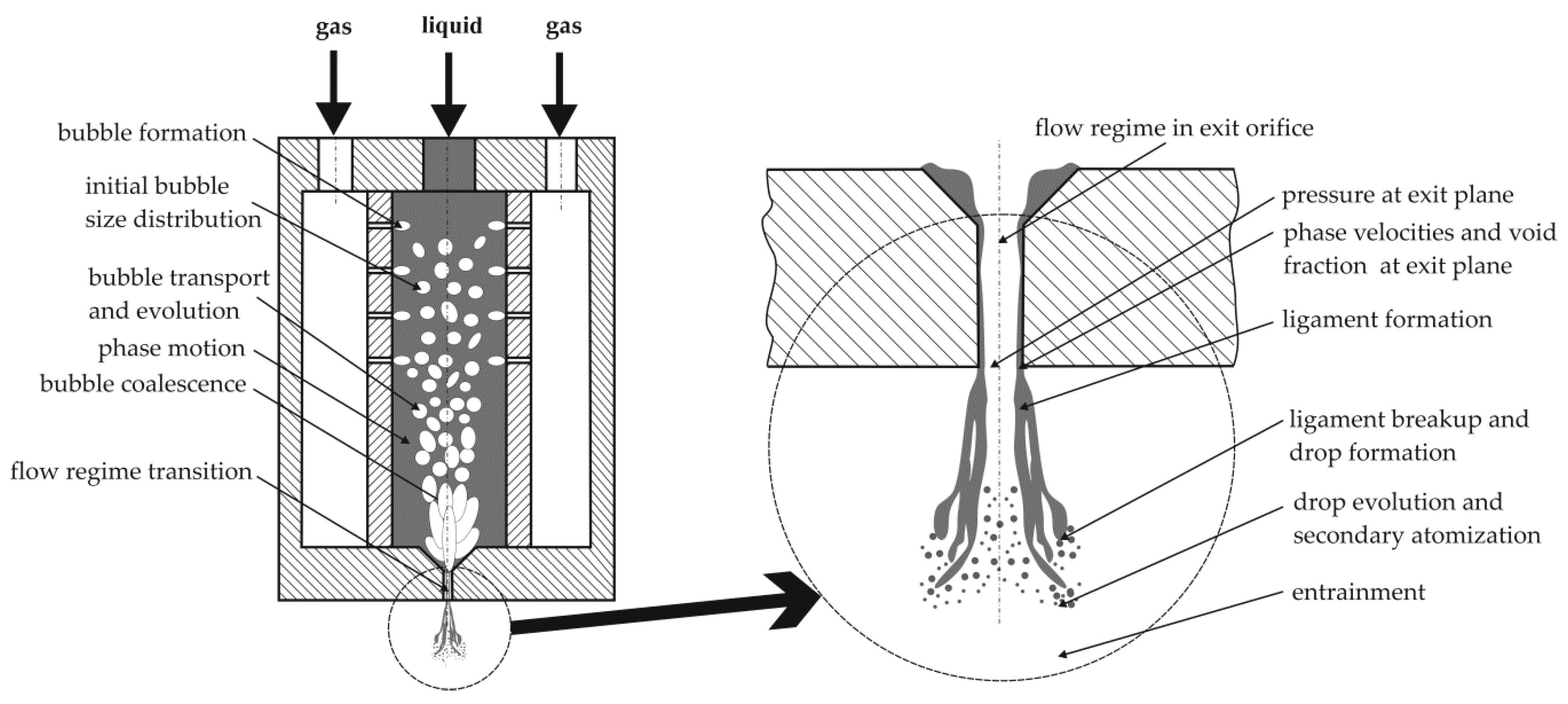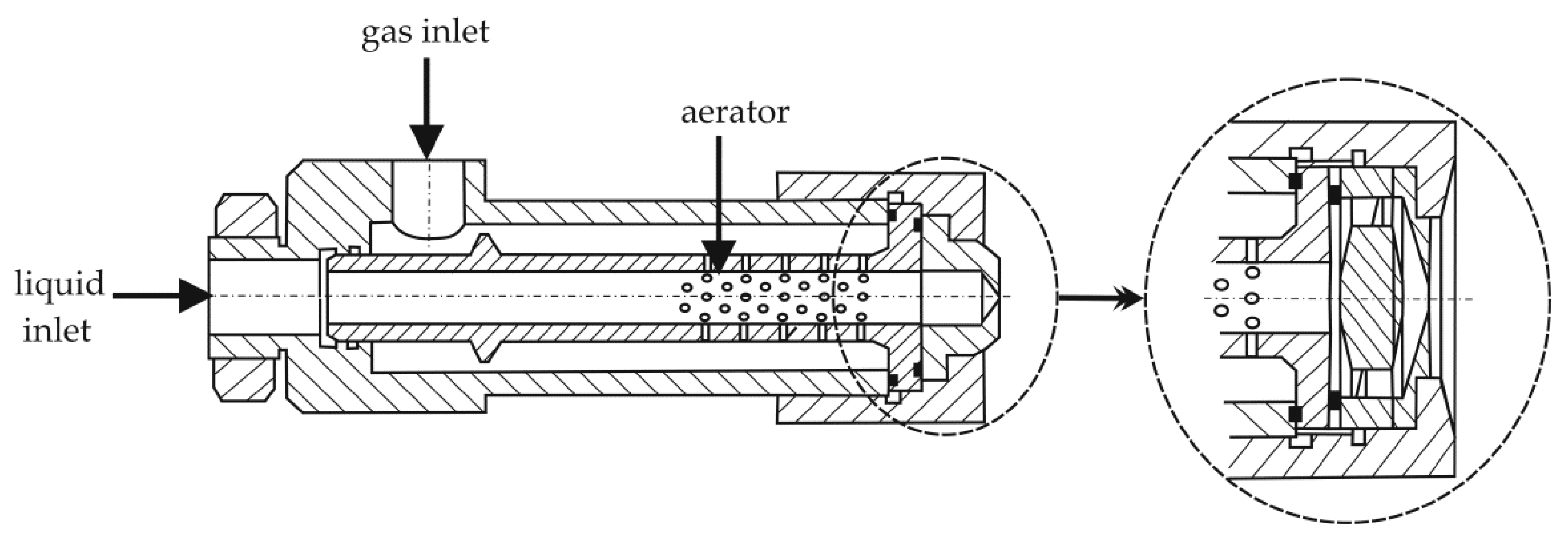State-of-the-Art Review of Effervescent-Swirl Atomizers
Abstract
1. Introduction
2. Design and Characteristics of Effervescent-Swirl Atomizers
2.1. Building, Construction, and Design
2.2. Liquid Flow Structures
2.3. Discharge Coefficient
2.4. Spray Angle
2.5. Droplet Diameter
- -
- immediately at the atomizer outlet opening:
- -
- in a situation where the distance from the atomizer outlet is small and does not exceed 10 mm:
- -
- when the distance from the atomizer outlet is greater than 10 but less than 200 mm:
3. Conclusions
- -
- Because, a comprehensive model of the atomization process is not yet available, there is considerable scope for efforts to model the subprocesses involved in effervescent-swirl atomization and to integrate them into a comprehensive model;
- -
- Due to different and different physico-chemical properties, the atomization of non-Newtonian liquids, suspensions and liquid metals should be tested;
- -
- In the future, it would be necessary to investigate and analyze the impact of various independent parameters on the unsteadiness of effervescent-swirl sprays, fluid mechanics of effervescent-swirl atomization, and perform modeling (CFD) of the process.
Author Contributions
Funding
Institutional Review Board Statement
Informed Consent Statement
Data Availability Statement
Acknowledgments
Conflicts of Interest
References
- Ochowiak, M. Koncepcja atomizera pęcherzykowo-wirowego z analizą oporów przepływu. Inżynieria Apar. Chem. 2012, 51, 360–361. [Google Scholar]
- Lefebvre, A.; McDonell, V. Atomization and Sprays; CRC Press Taylor & Francis Group: Boca Raton, FL, USA, 2017. [Google Scholar]
- Tonini, S.; Conti, P.; Cossali, G.E. Numerical modelling of internal flow in water mist injectors: Effect of nozzle geometry and operating conditions. Fire Technol. 2019, 55, 2395–2417. [Google Scholar] [CrossRef]
- Ochowiak, M.; Krupińska, A.; Włodarczak, S.; Matuszak, M.; Markowska, M.; Janczarek, M.; Szulc, T. The two-phase conical swirl atomizers: Spray characteristics. Energies 2020, 13, 3416. [Google Scholar] [CrossRef]
- Lefebvere, A.H. Atomization and Sprays; Hemisphere Publishing Corporation: New York, NY, USA, 1989. [Google Scholar]
- Orzechowski, Z.; Prywer, J. Wytwarzanie i Zastosowanie Rozpylonej Cieczy; WNT: Warszawa, Poland, 2008. (In Polish) [Google Scholar]
- Ochowiak, M. Analiza Procesu Rozpylania Cieczy w Rozpylaczach Pęcherzykowych i Pęcherzykowo-Wirowych; Habilitation Thesis; WPP; Poznan University of Technology: Poznań, Poland, 2014; p. 519. (In Polish) [Google Scholar]
- Sovani, S.D.; Sojka, P.E.; Lefebvere, A.H. Effervescent atomization. Prog. Energy Combust. Sci. 2001, 27, 483–521. [Google Scholar] [CrossRef]
- Dhivyaraja, K.; Gaddes, D.; Freeman, E.; Tadigadapa, S.; Panchagnula, M.V. Dynamical similarity and universality of drop size and velocity spectra in sprays. J. Fluid Mech. 2019, 860, 510–543. [Google Scholar] [CrossRef]
- Jarrahbashi, D.; Sirignano, W.A.; Popov, P.P.; Hussain, F. Early spray development at high gas density: Hole, ligament and bridge formations. J. Fluid Mech. 2016, 792, 186–231. [Google Scholar] [CrossRef]
- Chaussonnet, G.; Geppertha, S.; Holza, S.; Kocha, R.; Bauera, H.J. Influence of the ambient pressure on the liquid accumulation and on the primary spray in prefilming airblast atomization. Int. J. Multiph. Flow 2020, 125, 1–24. [Google Scholar] [CrossRef]
- Shao, C.; Luo, K.; Chal, M.; Fan, J. Sheet, ligament and droplet formation in swirling primary atomization. AIP Adv. 2018, 8, 045211. [Google Scholar] [CrossRef]
- En’urga Inc. High Flow Rate Effervescent Atomizer. Available online: www.enurga.com (accessed on 12 October 2010).
- Orzechowski, Z.; Prywer, J. Rozpylanie Cieczy w UrząDzeniach Energetycznych; WNT: Warszawa, Poland, 1994. (In Polish) [Google Scholar]
- Patil, D.P.; Laskowski, J.S. Development of zero conditioning procedure for coal reverse flotation. Miner. Eng. 2008, 21, 373–379. [Google Scholar] [CrossRef]
- Tricou, C.; Knasiak, K.F. Development of a High Transfer Efficiency Painting Technology Using Effervescent Atomization. In Proceedings of the ILASS–Americas, 18th Annual Conference on Liquid Atomization and Spray Systems, Irvine, CA, USA, 22–25 May 2005. [Google Scholar]
- Petersen, F.J.; Worts, O.; Schaefer, T.; Sojka, P.E. Design and atomization properties for and inside-out type effervescent atomizer. Drug Dev. Ind. Pharm. 2004, 30, 319–326. [Google Scholar] [CrossRef]
- Petersen, F.J.; Wørts, O.; Schaefer, T.; Sojka, P.E. Effervescent atomization of aqueous polymer solutions and dispersions. Pharm. Dev. Technol. 2001, 6, 201–210. [Google Scholar] [CrossRef] [PubMed]
- Piątkowski, M.; Zbiciński, I. Płomieniowe suszenie rozpyłowe. Inżynieria I Apar. Chem. 2010, 49, 87–88. (In Polish) [Google Scholar]
- Petersen, F.J. A New Approach for Pharmaceutical Sprays. Effervescent Atomization. Atomizer Design and Spray Characterization. Ph.D. Thesis, Department of Pharmaceutics, The Danish University of Pharmaceutical Sciences, Copenhagen, Danmark, 2004. [Google Scholar]
- O’Sullivan, J.J.; Norwood, E.A.; O’Mahony, J.A.; Kelly, A.L. Atomisation technologies used in spray drying in the dairy industry: A review. J. Food Eng. 2019, 243, 57–69. [Google Scholar] [CrossRef]
- Jayapal, S.; Kadiresh, R.M. Spray characteristics of plug type swirl injector. In Proceedings of the Advances in Science and Engineering Technology International Conferences (ASET), Dubai/Sharjah/Abu Dhabi, United Arab Emirates, 6 February–5 April 2018. [Google Scholar]
- Kim, K.; Lim, O. Investigation of the spray development process of gasoline-biodiesel blended fuel sprays in a constant volume chamber. Energies 2020, 13, 4819. [Google Scholar] [CrossRef]
- Panchasara, H.; Ashwath, N. Effects of pyrolysis bio-oils on guel atomization—A review. Energies 2021, 14, 794. [Google Scholar] [CrossRef]
- Kim, H.Y.; Ge, J.C.; Choi, N.J. Effects of fuel injection pressure on combustion and emission characteristics under low speed conditions in a diesel engine fueled with palm oil biodiesel. Energies 2019, 12, 3264. [Google Scholar] [CrossRef]
- Holz, S.; Braun, S.; Chaussonnet, G.; Koch, R.; Bauer, H.J. Close nozzle spray characteristics of a prefilming airblast atomizer. Energies 2019, 12, 2835. [Google Scholar] [CrossRef]
- Shinjo, J. Recent advances in computational modeling of primary atomization of liquid fuel sprays. Energies 2018, 11, 2971. [Google Scholar] [CrossRef]
- Payri, R.; García-Oliver, J.M.; Mendoza, V.; Viera, A. Analysis of the influence of diesel spray injection on the ignition and soot formation in multiple injection strategy. Energies 2020, 13, 3505. [Google Scholar] [CrossRef]
- Liu, C.; Liu, F.; Yang, J.; Mu, Y.; Hu, C.; Xu, G. Experimental investigations of spray generated by a pressure swirl atomizer. J. Energy Inst. 2019, 92, 210–221. [Google Scholar] [CrossRef]
- Lee, M.Y.; Lee, G.S.; Kim, C.J.; Seo, J.H.; Kim, K.H. Macroscopic and microscopic spray characteristics of diesel and gasoline in a constant volume chamber. Energies 2018, 11, 2056. [Google Scholar] [CrossRef]
- Fan, X.; Liu, C.; Mu, Y.; Wang, K.; Wang, Y.; Gang Xu, G. Experimental investigations of flow field and atomization field characteristics of pre-filming air-blast atomizers. Energies 2019, 12, 2800. [Google Scholar] [CrossRef]
- Isa, K.M.; Osman, K.; Yahya, A.; Ghaffar, Z.A.; Hamid, A.H.A.; Kasolang, S. Studies on the spray characteristics of pressure-swirl atomizers for automatic hand sanitizer application. J. Adv. Res. Fluid Mech. Therm. Sci. 2019, 55, 51–64. [Google Scholar]
- Golovanevsky, B.; Levy, Y. Fluid Image Velocimetry of the Flow in the Recirculation Zone of a Bluff Body Stabilized and Controlled Burner. In Proceedings of the 10th International Symposium on Applications of Laser Techniques to Fluid Mechanics, Lisbon, Portugal, 10–13 July 2000; pp. 1–10. [Google Scholar]
- Golovanevsky, B.; Levy, Y. Suppression of Combustion Instability Using an Aerodynamically Exited Atomizer. In Proceedings of the 11th International Symposium on Applications of Laser Techniques to Fluid Mechanics, Lisbon, Portugal, 8–11 July 2002; pp. 1–14. [Google Scholar]
- Sovani, S.D.; Chou, E.; Sojka, P.E.; Gore, J.P.; Eckerle, W.A.; Crofts, J.D. High pressure effervescent atomization: Effect of ambient pressure on spray cone angle. Fuel 2001, 80, 427–435. [Google Scholar] [CrossRef]
- Sovani, S.D.; Crofts, J.D.; Sojka, P.E.; Gore, J.P.; Eckerle, W.A. Structure and steady-state spray performance of an effervescent diesel injector. Fuel 2005, 84, 1503–1514. [Google Scholar] [CrossRef]
- Spicher, U. Direkteinspritzung im Ottomotor, III: Forschungsergebnisse und Aktueller Entwicklungsstand bei der Benzin-Direkteinspritzung; Expert Verlag: Renningen, Germany, 2001. [Google Scholar]
- Wu, S.R.; Cheng, W.C.; Chiao, J. Low NOx heavy fuel oil combustion with high temperature air. Fuel 2007, 86, 820–828. [Google Scholar] [CrossRef]
- Yu, G.; Li, J.G.; Zhao, J.R.; Yue, L.J.; Chang, X.Y.; Sung, C.J. An experimental study of kerosene combustion in a supersonic model combustor using effervescent atomization. Proc. Combust. Inst. 2005, 30, 2859–2866. [Google Scholar] [CrossRef]
- Sutherland, J.J.; Sojka, P.E.; Plesniak, M.W. Entrainment by ligament-controlled effervescent atomizer-produced sprays. Int. J. Multiph. Flow 1997, 23, 865–884. [Google Scholar] [CrossRef]
- Gong, J.S.; Fu, W.B. The experimental study on the flow characteristics for swirling gas-liquid spray atomizer. Appl. Therm. Eng. 2007, 27, 2886–2892. [Google Scholar] [CrossRef]
- Chin, J.S.; Lefebvre, A.H. A design procedure for effervescent atomizers. J. Eng. Gas Turbines Power 1995, 117, 226–271. [Google Scholar] [CrossRef]
- Sher, E.; Bar-Kohany, T.; Rashkovan, A. Flash-boiling atomization. Prog. Energy Combust. Sci. 2008, 34, 417–439. [Google Scholar] [CrossRef]
- Ochowiak, M.; Broniarz-Press, L.; Różański, J. The discharge coefficient of effervescent atomizers. Exp. Therm. Fluid Sci. 2010, 34, 1316–1323. [Google Scholar] [CrossRef]
- Broniarz-Press, L.; Ochowiak, M.; Woziwodzki, S. Atomization of PEO aqueous solutions in effervescent atomizers. Int. J. Heat Fluid Flow 2010, 31, 651–658. [Google Scholar] [CrossRef]
- Hammad, F.A.; Sun, K.; Che, Z.; Jedelsky, J.; Wang, T. Internal two-phase flow and spray characteristics of outside-in-liquid twin-fluid atomizers. Appl. Therm. Eng. 2021, 187, 116555. [Google Scholar] [CrossRef]
- Kourmatzis, A.; Lowe, A.; Masri, A.R. Combined effervescent and airblast atomization of a liquid jet. Exp. Therm. Fluid Sci. 2016, 75, 66–76. [Google Scholar] [CrossRef]
- Jedelský, J.; Jícha, M. Spray characteristics and liquid distribution of multi-hole effervescent atomisers for industrial burners. Appl. Therm. Eng. 2016, 96, 286–296. [Google Scholar] [CrossRef]
- Chen, B.; Gao, D.; Li, Y.; Chen, C.; Yuan, X.; Wang, Z.; Sun, P. Investigation of the droplet characteristics and size distribution during the collaborative atomization process of a twin-fluid nozzle. Int. J. Adv. Manuf. Technol. 2020, 107, 1625–1639. [Google Scholar] [CrossRef]
- Ghaffar, Z.A.; Kasolang, S.; Hussein, A.; Hamid, A. Characteristics of swirl effervescent atomizer spray angle. Appl. Mech. Mater. 2014, 607, 108–111. [Google Scholar] [CrossRef]
- Ghaffar, Z.A.; Kasolang, S.; Hussein, A.; Hamid, A.; Ahmed, D.I.; Sainan, K.I.; Roselina, N.; Roseley, N. Gas core characteristics of swirl effervescent atomizer. J. Teknol. 2015, 76, 58–62. [Google Scholar]
- Ghaffar, Z.A.; Kasolang, S.; Hussein, A.; Hamid, A.; Chee Sheng, O.; Azlina, M.; Bakar, A. Effect of geometrical parameters interaction on swirl effervescent atomizer spray angle. J. Teknol. 2015, 76, 63–67. [Google Scholar]
- Chen, S.K.; Lefebvre, A.H. Spray cone angles of effervescent atomizers. At. Sprays 1994, 4, 291–301. [Google Scholar]
- Lefebvre, A.H.; Wang, X.F.; Martin, C.A. Spray characteristics of aerated-liquid pressure atomizers. J. Propuls. Power 1988, 4, 293–298. [Google Scholar] [CrossRef]
- Lund, M.T.; Sojka, P.E.; Lefebvre, A.H.; Gosselin, P.G. Effervescent atomization at low mass flow rates. Part 1: The influence of surface tension. At. Sprays 1993, 3, 77–89. [Google Scholar]
- Ochowiak, M.; Broniarz-Press, L. Atomization performance of effervescent atomizers with gas-liquid internal mixing. Pol. J. Chem. Technol. 2008, 10, 38–41. [Google Scholar] [CrossRef]
- Panchagnula, M.V.; Sojka, P.E. Spatial droplet velocity and size profiles in effervescent atomizer-produced sprays. Fuel 1999, 78, 729–741. [Google Scholar] [CrossRef]
- Whitlow, J.D.; Lefebvre, A.H. Effervescent atomizer operation and spray characteristics. At. Sprays 1993, 3, 137–156. [Google Scholar] [CrossRef]
- Whitlow, J.D.; Lefebvre, A.H.; Rollbuhler, J.R. Experimental studies on effervescent atomizers with wide spray angles. Advis. Group Aerosp. Res. Dev. Conf. Proc. 1993, 536, 1–11. [Google Scholar]
- Optimizing Your Spray System. Spray Nozzle Maintenance and Control for Improved Production Efficiency. In Proceedings of the ILASS–Americas, 17th Annual Conference on Liquid Atomization and Spray Systems, Irvine, CA, USA, 13–17 July 2003.
- Lefebvre, A.H. Twin-Fluid Atomization: Factors Influencing Mean Drop Size. In Proceedings of the 5th International Conference Liquid Atomization & Spray Systems, Gaithersburg, MD, USA, 15–18 July 1991; pp. 49–64. [Google Scholar]
- Ochowiak, M. Experimental study on effect of aqueous suspension of silica additives on the atomization process in effervescent nozzles. Chem. Process Eng. 2010, 31, 35–42. [Google Scholar]
- Jicha, M.; Jedelsky, J.; Otahal, J.; Slama, J. Influence of some geometrical parameters on the characteristics of effervescent atomization. In Proceedings of the 18th European Conference on Liquid Atomization and Spray Systems ILASS-Europe, Zaragoza, Spain, 9–11 September 2002; pp. 1–6. [Google Scholar]
- Lefebvre, A.H. Some recent developments in twin-fluid atomization. Part. Part. Syst. Charact. 1996, 13, 205–216. [Google Scholar] [CrossRef]
- Buckner, H.E.; Sojka, P.E. Effervescent atomization of high viscosity fluids. Part 1: Newtonian liquids. At. Sprays 1991, 1, 239–252. [Google Scholar] [CrossRef]
- Buckner, H.E.; Sojka, P.E. Effervescent atomization of high viscosity fluids. Part 2: Non-Newtonian liquids. At. Sprays 1993, 3, 157–170. [Google Scholar] [CrossRef]
- Chin, J.S.; Lefebvre, A.H. Flow patterns in internal-mixing, twin-fluid atomizers. At. Sprays 1993, 3, 463–475. [Google Scholar] [CrossRef]
- Wang, X.F.; Chin, J.S.; Lefebvre, A.H. Influence of gas injector geometry on atomization performance of aerated-liquid nozzles. Int. J. Turbo Jet Engines 1989, 6, 271–279. [Google Scholar] [CrossRef]
- Kim, H.G.; Yano, T.; Song, K.K.; Shuichi, T. Microscopic spray characteristics in the effervescent atomizer with two aerator tubes. Ksme Int. J. 2004, 18, 1661–1667. [Google Scholar] [CrossRef]
- Kushari, A. Effect of injector geometry on the performance of an internally mixed liquid atomizer. Fuel Process. Technol. 2010, 91, 1650–1654. [Google Scholar] [CrossRef]
- Li, J.; Lefebvre, A.H.; Rollbuhler, J.R. Effervescent atomizers for small gas turbines. Am. Soc. Mech. Eng. 1994, 78859, V003T06A048. [Google Scholar]
- Qian, L.; Lin, J.; Xiong, H. A fitting formula for predicting droplet mean diameter for various liquid in effervescent atomization spray. J. Therm. Spray Technol. 2010, 19, 586–601. [Google Scholar] [CrossRef]
- Ulbrich, R. Wykorzystanie Metod Analizy Obrazu do Oceny Nierównomierności Przepływu Gaz–Ciecz w Elementach Płaszczowo-Rurowego Wymiennika Ciepła; Oficyna Wydawnicza Politechniki Opolskiej: Opole, Poland, 2006. (In Polish) [Google Scholar]
- Zając, D.; Ulbrich, R. Nieinwazyjne Metody Badań Przepływów Dwufazowych Gaz–Ciecz; Oficyna Wydawnicza Politechniki Opolskiej: Opole, Poland, 2005. (In Polish) [Google Scholar]
- Jedelsky, J.; Maly, M.; Del Corral, N.P.; Wigley, G.; Janackova, L.; Jicha, M. Air–liquid interactions in a pressure-swirl spray. Int. J. Heat Mass Transf. 2018, 121, 788–804. [Google Scholar] [CrossRef]
- Bar-Kohany, T.; Levy, M. State of the art review of flash-boiling atomization. At. Sprays 2016, 26, 1259–1305. [Google Scholar] [CrossRef]
- Czernek, K. Hydrodynamiczne Aspekty Projektowania Aparatów Cienkowarstewkowych dla Cieczy Bardzo Lepkich; Oficyna Wydawnicza Politechniki Opolskiej: Opole, Poland, 2013. (In Polish) [Google Scholar]
- Dziubiński, M.; Prywer, J. Mechanika Płynów Dwufazowych; WNT: Warszawa, Poland, 2009. (In Polish) [Google Scholar]
- Orzechowski, Z. Przepływy Dwufazowe Jednowymiarowe Ustalone Adiabatyczne; PWN: Warszawa, Poland, 1990. (In Polish) [Google Scholar]
- Orzechowski, Z.; Prywer, J. Przepływy Dwufazowe; Wydawnictwo Politechniki Łódzkiej: Łódź, Poland, 1991. (In Polish) [Google Scholar]
- Orzechowski, Z.; Prywer, J. Rozpylanie Cieczy; WNT: Warszawa, Poland, 1991. (In Polish) [Google Scholar]
- Orzechowski, Z.; Prywer, J.; Zarzycki, R. Mechanika Płynów w Inżynierii Środowiska; WNT: Warszawa, Poland, 1997. (In Polish) [Google Scholar]
- Bhagwat, S.M. Study of Flow Patterns and Void Fraction in Vertical Downward Two Phase Flow. Master’s Thesis, Oklahoma State University, Tulsa, OK, USA, 2011. [Google Scholar]
- Rahman, M.A.; Balzan, M.; Heidrick, T.; Fleck, B.A. Effects of the gas phase molecular weight and bubble size on effervescent atomization. Int. J. Multiph. Flow 2012, 38, 35–52. [Google Scholar] [CrossRef]
- Hussein, A.; Hafiz, M.; Rashid, H.; Halim, A.; Wisnoe, W.; Kasolang, S. Characteristics of Hollow Cone Swirl Spray at Various Nozzle Orifice Diameters. Jurnal Teknologi 2012, 58, 1–4. [Google Scholar] [CrossRef][Green Version]
- Różańska, S. Extensional viscosity of w/o emulsions. Procedia Eng. 2012, 42, 742–752. [Google Scholar] [CrossRef]
- Różańska, S.; Broniarz-Press, L.; Różański, J.; Mitkowski, P.; Ochowiak, M.; Woziwodzki, S. Extensional viscosity and stability of oil-in-water emulsions with addition poly(ethylene oxide). Procedia Eng. 2012, 42, 733–741. [Google Scholar] [CrossRef][Green Version]
- Sutherland, J.J.; Sojka, P.E.; Plesniak, M.W. Ligament controlled effervescent atomization. At. Sprays 1997, 7, 383–406. [Google Scholar] [CrossRef]
- Asihmin, V.I.; Geller, Z.I.; Skobel’cyn, Y.A. Discharge of a real fluid from cylindrical orifices. Oil Ind. 1961, 9, 135–172. [Google Scholar]
- Broniarz-Press, L.; Ochowiak, M.; Różański, J.; Szaferski, W.; Woziwodzki, S. Przepływ Trójfazowy Gaz–Ciecz–Ciecz w Dyszach Rozpryskowych; Wydawnictwo Politechniki Poznańskiej: Poznań, Poland, 2010. (In Polish) [Google Scholar]
- Nakayama, Y. Action of the fluid in the air micrometer: First report, characteristics of small diameter nozzle and orifice. Bull. Jpn. Soc. Mech. Eng. 1961, 4, 516–524. [Google Scholar] [CrossRef]
- Koch, R.; Noworyta, A. Procesy Mechaniczne w Inżynierii Chemicznej; WNT: Warszawa, Poland, 1998. (In Polish) [Google Scholar]
- Marcinkowski, A.; Dziubiński, M. Discharge coefficient for discharge of non-newtonian liquids form vessel. Chem. Eng. Proc. 2004, 25, 1297–1302. (In Polish) [Google Scholar]
- Ochowiak, M. The experimental study on the viscosity effect on the discharge coefficient for effervescent atomizers. Exp. Therm. Fluid Sci. 2013, 50, 187–192. [Google Scholar] [CrossRef]
- Dafsari, R.A.; Lee, H.J.; Han, J.; Park, D.C.; Lee, J. Viscosity effect on the pressure swirl atomization of an alternative aviation fuel. Fuel 2019, 240, 179–191. [Google Scholar] [CrossRef]
- Chen, S.K.; Lefebvre, A.H. Discharge coefficients for plain-orifice effervescent atomizers. At. Sprays 1994, 4, 275–290. [Google Scholar]
- Ramamurthi, K.; Sarkar, U.K.; Raghunandan, B.N. Performance characteristics of effervescent atomizer in different flow regimes. At. Sprays 2009, 19, 41–56. [Google Scholar] [CrossRef]
- Jedelsky, J.; Jichma, M. Prediction of discharge coefficient of internally-mixed twin-fluid atomizers. In Proceedings of the 24th European Conference on Liquid Atomization and Spray Systems ILASS-Europe, Lisbon/Estoril, Portugal, 5–7 September 2011; pp. 1–6. [Google Scholar]
- Ochowiak, M.; Matuszak, M.; Włodarczak, S.; Krupińska, A.; Markowska, M.; Gościniak, A.; Szulc, T. The concept design and study of twin-fluid effervescent atomizer with air stone aerator. Chem. Eng. Proc. Process Intensif. 2018, 124, 24–28. [Google Scholar] [CrossRef]
- Jedelsky, J.; Jichma, M.; Slama, J. Discharge coefficient and operational flow characteristics of multihole effervescent atomizer. In Proceedings of the 9th International Conference on Liquid Atomization and Spray Systems ICLASS, Sorrento, Italy, 13–17 July 2003; pp. 1–6. [Google Scholar]
- Dziubiński, M.; Przelazły, L. Liquid discharge coefficient for irregularly shaped orifices. Chem. Eng. Equip. 2009, 48, 31–33. [Google Scholar]
- Dikshit, S.; Channiwala, S.; Kulshreshtha, D.; Chaudhari, K. Experimental investigations of performance parameters of pressure swirl atomizer for kerosene type fuel. In Proceedings of the ASME Turbo Expo 2009: Power for Land, Sea, and Air, Orlando, FL, USA, 8–12 June 2009; GT2009-59084. Volume 2, pp. 61–78. [Google Scholar]
- Mishra, D.P.; Singh, G. Experimental study of an internally mixed liquid atomizer for an air-breathing engine application. In Proceedings of the 11th International Conference on Liquid Atomization and Spray Systems ICLASS, Vail, CO, USA, 26–30 July 2009; pp. 1–6. [Google Scholar]
- Dikshit, S.B.; Kulshreshta, D.B.; Channiwala, S.A. Factors affecting spray cone angle of pressure swirl atomizer for gas turbine combustion chamber: Theoretical and experimental analysis. Indian J. Sci. Technol. 2018, 11, 1–4. [Google Scholar] [CrossRef]
- Wade, R.A.; Weerts, J.M.; Sojka, P.E.; Gore, J.P.; Eckerle, W.A. Effervescent atomization at injection pressures in MPa range. At. Sprays 1999, 9, 651–667. [Google Scholar] [CrossRef]
- Jedelsky, J.; Landsmann, M.; Jichma, M.; Kuritka, I. Effervescent atomizer: Influence of the operation conditions and internal geometry on spray structure; study using PIV-PLIF. In Proceedings of the 22th European Conference on Liquid Atomization and Spray Systems ILASS-Europe, Como Lake, Italy, 8–10 September 2008; pp. 1–8. [Google Scholar]
- Loebker, D.W.; Empie, H.J. Effervescent Spraying of a Medium to High Viscosity Newtonian Fluid at High Mass Flow Rates; Technical Paper; Institute of Paper Science and Technology: Atlanta, GA, USA, 1998; Volume 62, pp. 1–14. [Google Scholar]
- Loebker, D.W.; Empie, H.J. Independently Controlled Drop Size in Black Liquor Sprays to the Kraft Recovery Boiler Using Effervescent Atomization; Technical Paper; Institute of Paper Science and Technology: Atlanta, GA, USA, 1999; Volume 823, pp. 1–18. [Google Scholar]
- Ochowiak, M.; Broniarz-Press, L.; Różańska, S. The analysis of liquid jet break-up in a one- and two-phase flows. Chem. Eng. Technol. 2012, 35, 1685–1691. [Google Scholar] [CrossRef]
- Ochowiak, M.; Broniarz-Press, L.; Różańska, S.; Różański, J. The effect of exten-sional viscosity on the effervescent atomization of polyacrylamide solutions. J. Ind. Eng. Chem. 2012, 18, 2028–2035. [Google Scholar] [CrossRef]
- Ochowiak, M.; Broniarz-Press, L.; Woziwodzki, S. The analysis of silica suspensions atomization. Int. J. Heat Fluid Flow 2011, 32, 1208–1215. [Google Scholar] [CrossRef]
- Gao, D.; Sun, Y.; Zhang, G. Numerical simulation of atomization characteristics of swirl nozzle. Icic Express Lett. 2018, 12, 277–285. [Google Scholar]
- Ochowiak, M. The effervescent atomization of oil-in-water emulsions. Chem. Eng. Process. Process Intensif. 2012, 52, 92–101. [Google Scholar] [CrossRef]
- Lefebvre, A.H.; McDonell, V.G. Atomization and Sprays, 2nd ed.; CRC Press, Taylor and Francis Group: Boca Raton, FL, USA, 2017. [Google Scholar]
- Ochowiak, M.; Broniarz-Press, L.; Włodarczak, S.; Markuszewska, M. Effervescent atomization of glicerol aqueous solutions. Trans. Inst. Fluid-Flow Mach. 2013, 125, 29–38. [Google Scholar]
- Gemci, T.; Yakut, K.; Chigier, N.; Ho, T.C. Experimental study of flash atomization of binary hydrocarbon liquids. Int. J. Multiph. Flow 2004, 30, 395–417. [Google Scholar] [CrossRef]
- Jedelsky, J.; Jichma, M. Novel modifications of twin-fluid atomizers: Performance, advantages and drawbacks. In Proceedings of the 23th European Conference on Liquid Atomization and Spray Systems ILASS-Europe, Brno, Czech Republic, 6–8 September 2010; pp. 1–5. [Google Scholar]
- Jedelsky, J.; Otahal, J.; Jichma, M. Effervescent atomizer for atomization of suspensions containing large particles. In Proceedings of the 22th European Conference on Liquid Atomization and Spray Systems ILASS-Europe, Como Lake, Italy, 8–10 September 2008; pp. 1–4. [Google Scholar]
- Ghaffar, Z.A.; Hamid, A.H.A.; Rashid, M.S.F.M. Spray characteristics of swirl effervescent injector in rocket application: A review. Appl. Mech. Mater. 2012, 225, 423–428. [Google Scholar] [CrossRef]
- Santangelo, P.J.; Sojka, P.E. A holographic investigation of the near nozzle structure of an effervescent atomizer produced spray. At. Sprays 1995, 5, 137–155. [Google Scholar] [CrossRef]
- Santangelo, P.J.; Sojka, P.E. Focused image holography as a dense spray diagnostic. Appl. Opt. 1994, 33, 4132–4136. [Google Scholar] [CrossRef] [PubMed]
- Weber, C. Disintegration of liquid jets. Z. Für Angew. Math. Und Mech. 1931, 11, 136–159. [Google Scholar] [CrossRef]
- Smith, M.W. Utilization of effervescent spray technology to eliminate volatile and toxic diluents. In Paper of Low- and No-VOC Coating Technologies: 2nd Biennial International Conference; Research Triangle Institute: Durham, NC, USA, 1995. [Google Scholar]
- Esfarjani, S.A.; Dolatabadi, A. A 3D simulation of two-phase flow in an effervescent atomizer for suspension plasma spray. Surf. Coat. Technol. 2009, 203, 2074–2080. [Google Scholar] [CrossRef]
- Sterling, A.; Sleicher, C. The instability of capillary jets. J. Fluid Mech. 1975, 68, 477–495. [Google Scholar] [CrossRef]
- Sovani, S.D.; Sojka, P.E.; Sivathanu, Y.R. Prediction of drop size distributions from first principles: The influence of fluctuations in relative velocity and liquid physical properties. At. Sprays 1999, 9, 133–152. [Google Scholar] [CrossRef]
- Sovani, S.D.; Sojka, P.E.; Sivathanu, Y.R. Predictions of drop size distributions from first principles: Joint PDF effect. At. Sprays 2000, 10, 587–602. [Google Scholar] [CrossRef]
- Liu, L.; Pei, N.; Zhao, R.; Tian, L.; Duan, R.; Zhang, Y.; Li, M.; Zhang, X. Effect of the two-phase hybrid mode of effervescent atomizer on the atomization characteristics. Open Phys. 2019, 17, 960–965. [Google Scholar] [CrossRef]
- Kourmatzis, A.; Lowe, A.; Masri, A.R. Conditioned analysis of effervescent atomization. J. Energy Eng. 2017, 143, 1–33. [Google Scholar] [CrossRef]
- White, F.M. Viscous Fluid Flow; McGraw-Hill: New York, NY, USA, 1992. [Google Scholar]
- Wang, M.R.; Lin, T.C.; Lai, T.S.; Tseng, I.R. Atomization performance of an atomizer with internal impingement. Jsme Int. J. Ser. B Fluids Therm. Eng. 2005, 48, 858–864. [Google Scholar] [CrossRef]
- Harari, R.; Sher, E. Optimization of a plain-jet atomizer. At. Sprays 1996, 6, 97–113. [Google Scholar]
- Mulhem, B.; Schulte, G.; Fritsching, U. Solid-liquid separation in suspension atomization. Chem. Eng. Sci. 2006, 61, 2582–2589. [Google Scholar] [CrossRef]
- Liu, M.; Duan, Y.; Zhang, T. Evaluation of effervescent atomizer internal design on the spray unsteadiness using a phase/Doppler particle analyzer. Exp. Therm. Fluid Sci. 2010, 34, 657–665. [Google Scholar] [CrossRef]
- Liu, M.; Duan, Y.; Zhang, T.; Xu, Y. Evaluation of unsteadiness in effervescent sprays by analysis of droplet arrival statistics—The influence of fluids properties and atomizer internal design. Exp. Therm. Fluid Sci. 2011, 35, 190–198. [Google Scholar] [CrossRef]
- Qian, L.J.; Lin, J.Z. Modeling on effervescent atomization: A review. Phys. Mech. Astron. 2011, 54, 2109–2129. [Google Scholar] [CrossRef]
- Lin, J.Z.; Qian, L.J.; Xiong, H. Relationship between deposition properties and operating parameters for droplet onto surface in the atomization impinging spray. Powder Technol. 2009, 191, 340–348. [Google Scholar] [CrossRef]
- Xiong, H.B.; Lin, J.Z.; Zhu, Z.F. Three-dimensional simulation of effervescent atomization spray. At. Sprays 2008, 19, 75–90. [Google Scholar] [CrossRef]
- Sankar, S.V.; Robart, D.M.; Bachalo, W.D. Swirl effervescent atomizer for spray combustion. Asme Htd 1995, 317, 175–182. [Google Scholar]
- Lund, M.T.; Sojka, P.E. Effervescent atomization at low mass flow-rates. Part 2: The structure of spray. In Proceedings of the 5th Annual Conference on Liquid Atomization and Spray Systems, San Ramon, CA, USA, 18–20 May 1992; pp. 233–237. [Google Scholar]
- Jedelsky, J.; Jichma, M. Unsteadiness in effervescent sprays—Measurement and evaluation using combined PIV-PLIF technique. In Proceedings of the 13th International Symposium on Applications of Laser Techniques to Fluid Mechanics, Lisbon, Portugal, 26–29 June 2006; pp. 1–10. [Google Scholar]
- Lund, M.T.; Jian, C.Q.; Sojka, P.E.; Gore, J.P.; Panchagnula, M.V. The influence of atomizing gas molecular weight on low mass flow rate effervescent atomization. J. Fluids Eng. 1998, 120, 750–754. [Google Scholar] [CrossRef]
- Broniarz-Press, L.; Ochowiak, M.; Markuszewska, M.; Włodarczak, S. Effect of polyethylene oxide addition on drop si histograms for the Medel Family inhaler. Chem. Eng. Equip. 2013, 52, 157–158. (In Polish) [Google Scholar]
- Mun, R.P.; Young, B.W.; Boger, D.V. Atomisation of dilute polymer solutions in agricultural spray nozzles. J. Non-Newton. Fluid Mech. 1999, 83, 163–178. [Google Scholar] [CrossRef]
- Zhu, H.; Dexter, R.W.; Fox, R.D.; Reichard, D.L.; Brazee, R.D.; Ozkan, H.E. Effect of polymer composition and viscosity on droplet size of recirculated spray solutions. J. Agric. Eng. Res. 1997, 67, 35–45. [Google Scholar] [CrossRef]
- Williams, P.A.; Eeblish, R.J.; Blanchard, R.L.; Rose, S.A.; Lyons, L.; Whitehead, M. The influence of the extensional viscosity of very low concentrations of high molecular mass water-soluble polymers on atomisation and droplet impact. Pest Manag. Sci. 2008, 64, 497–504. [Google Scholar] [CrossRef] [PubMed]
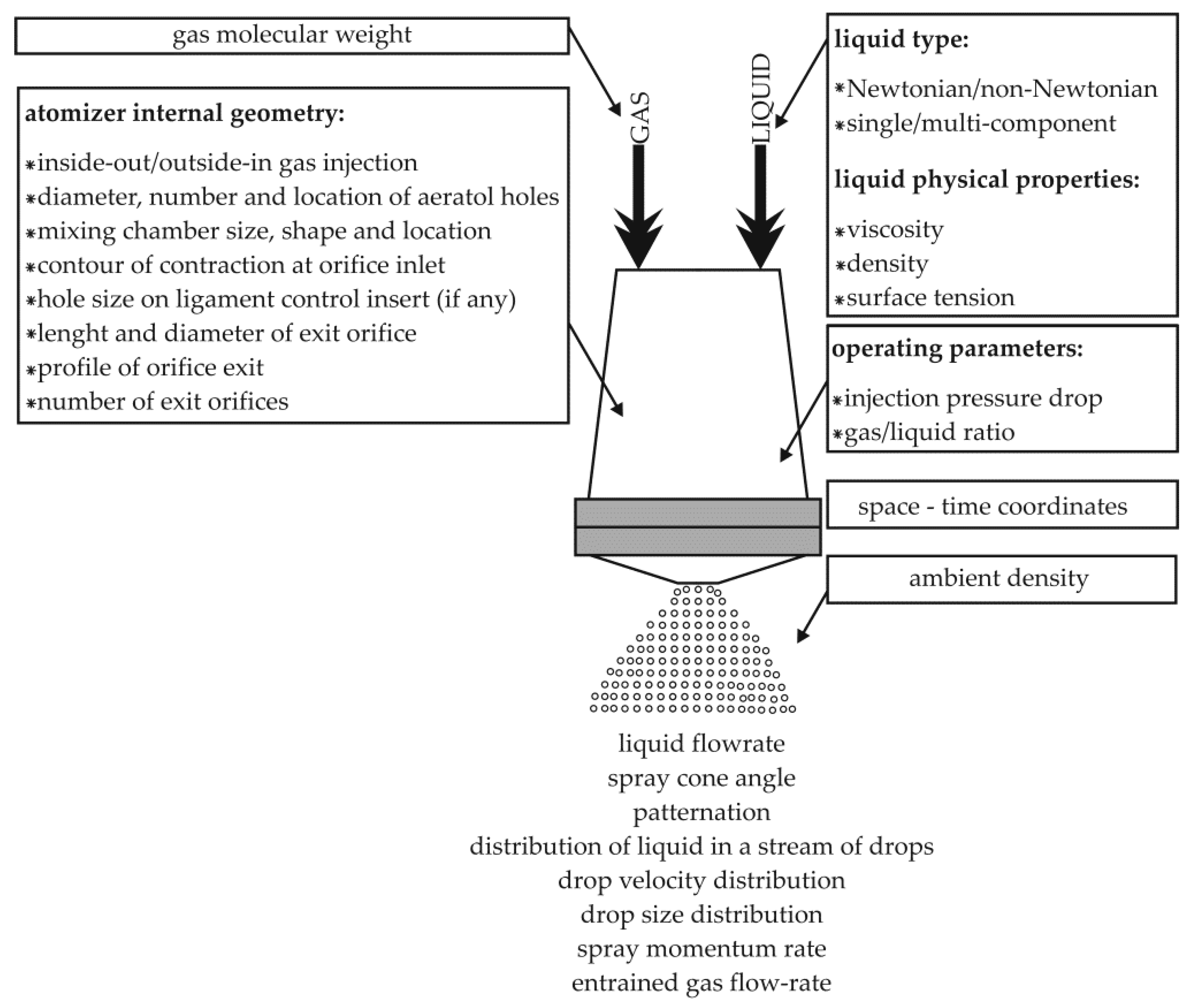
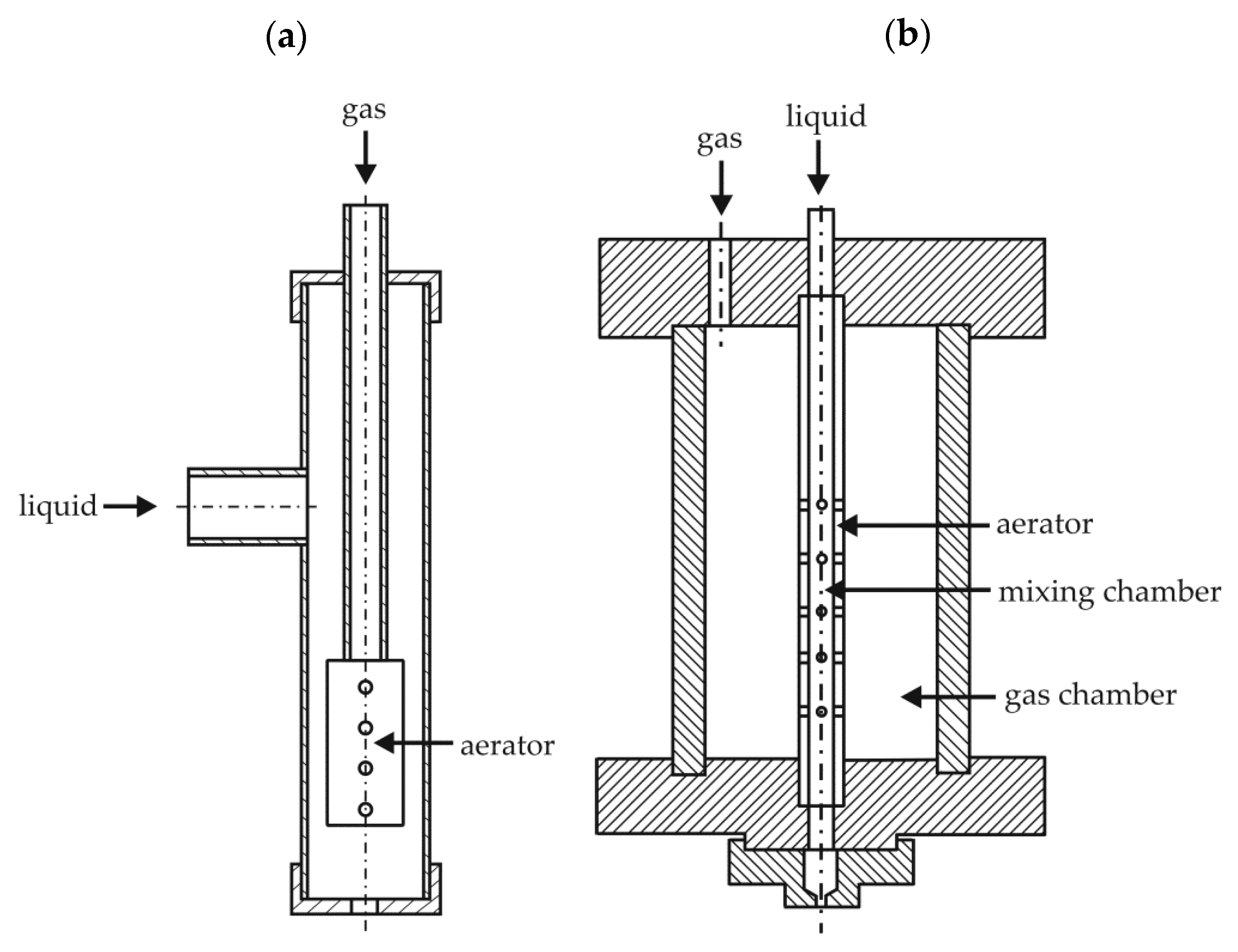
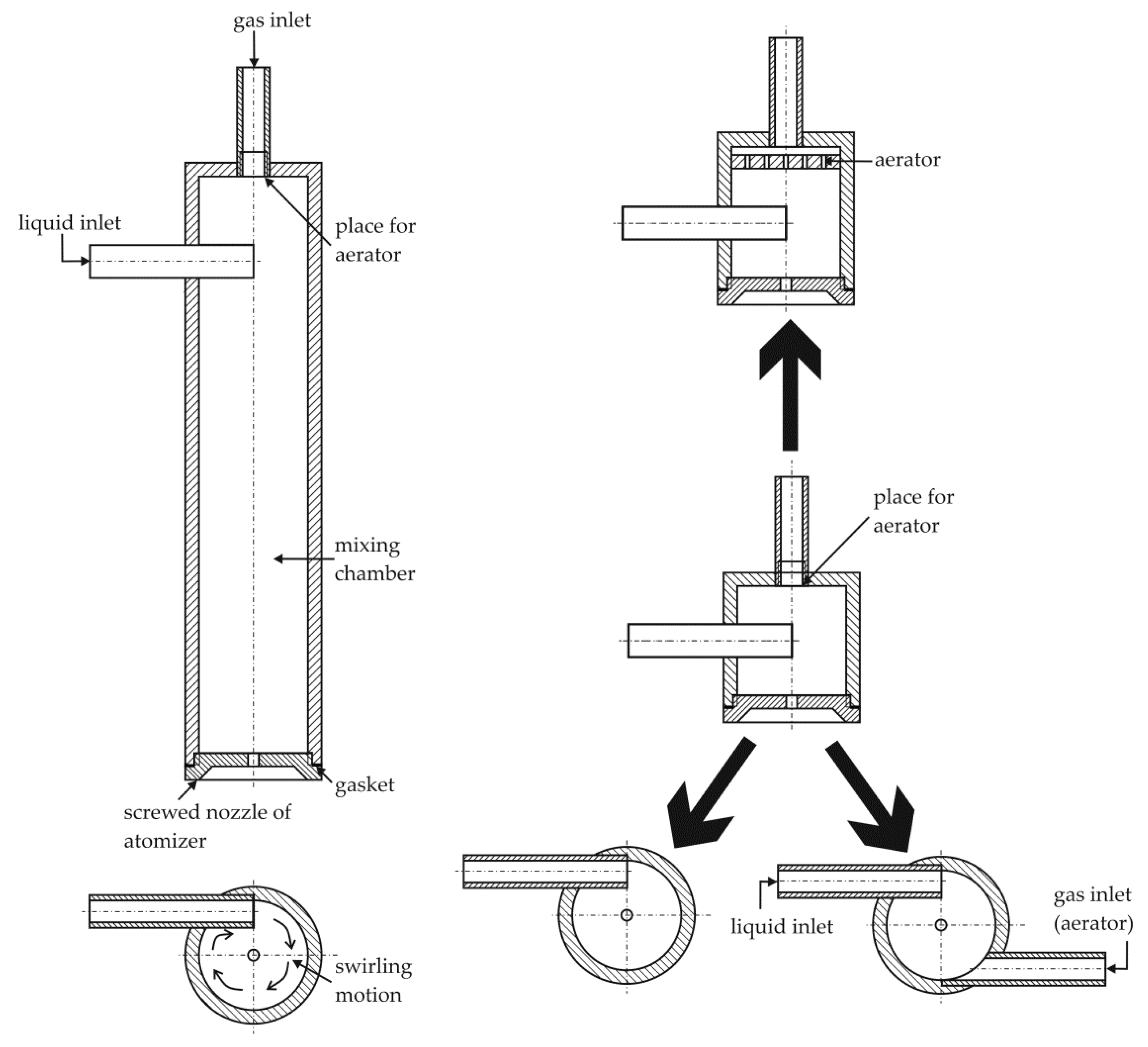
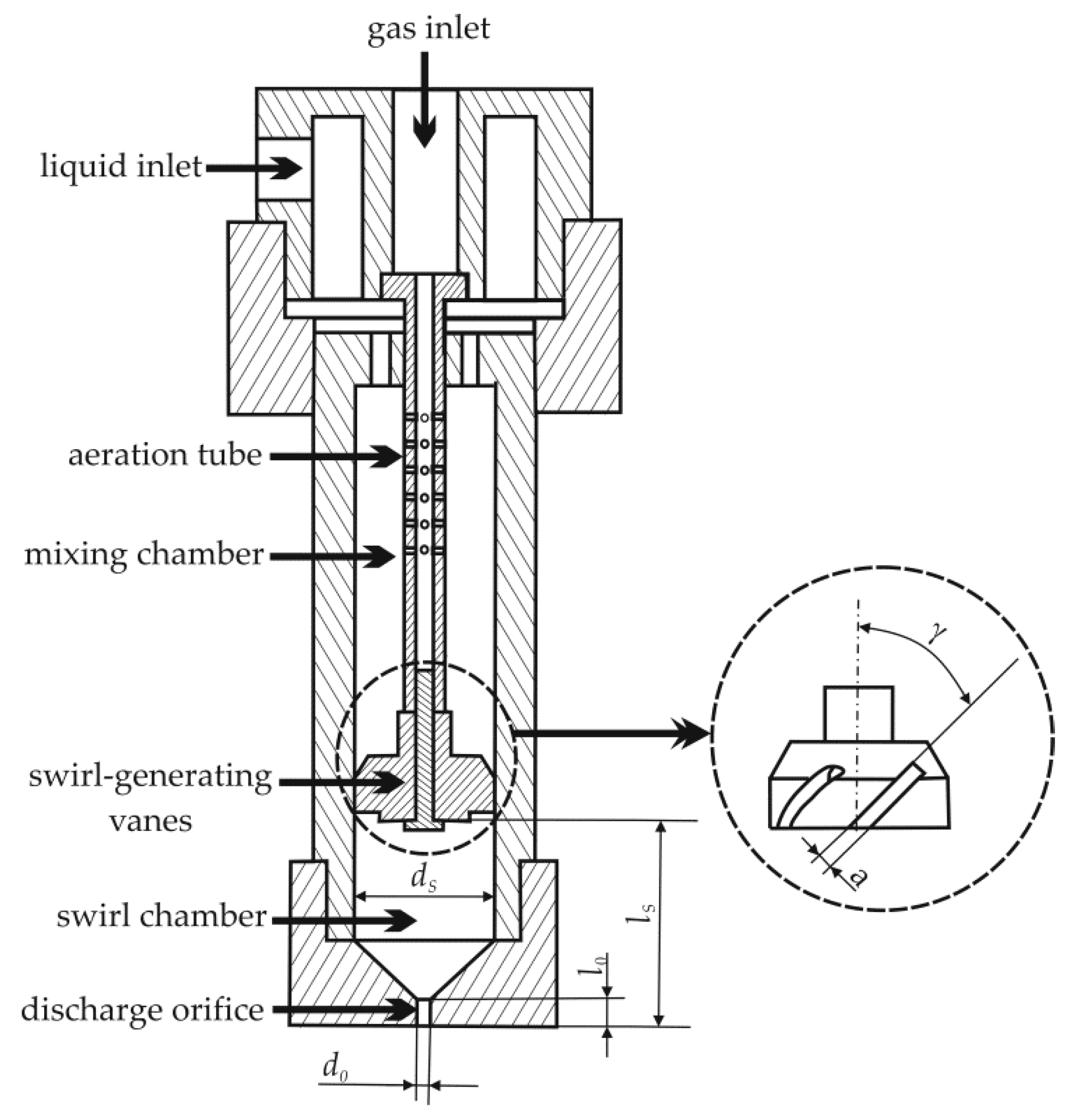
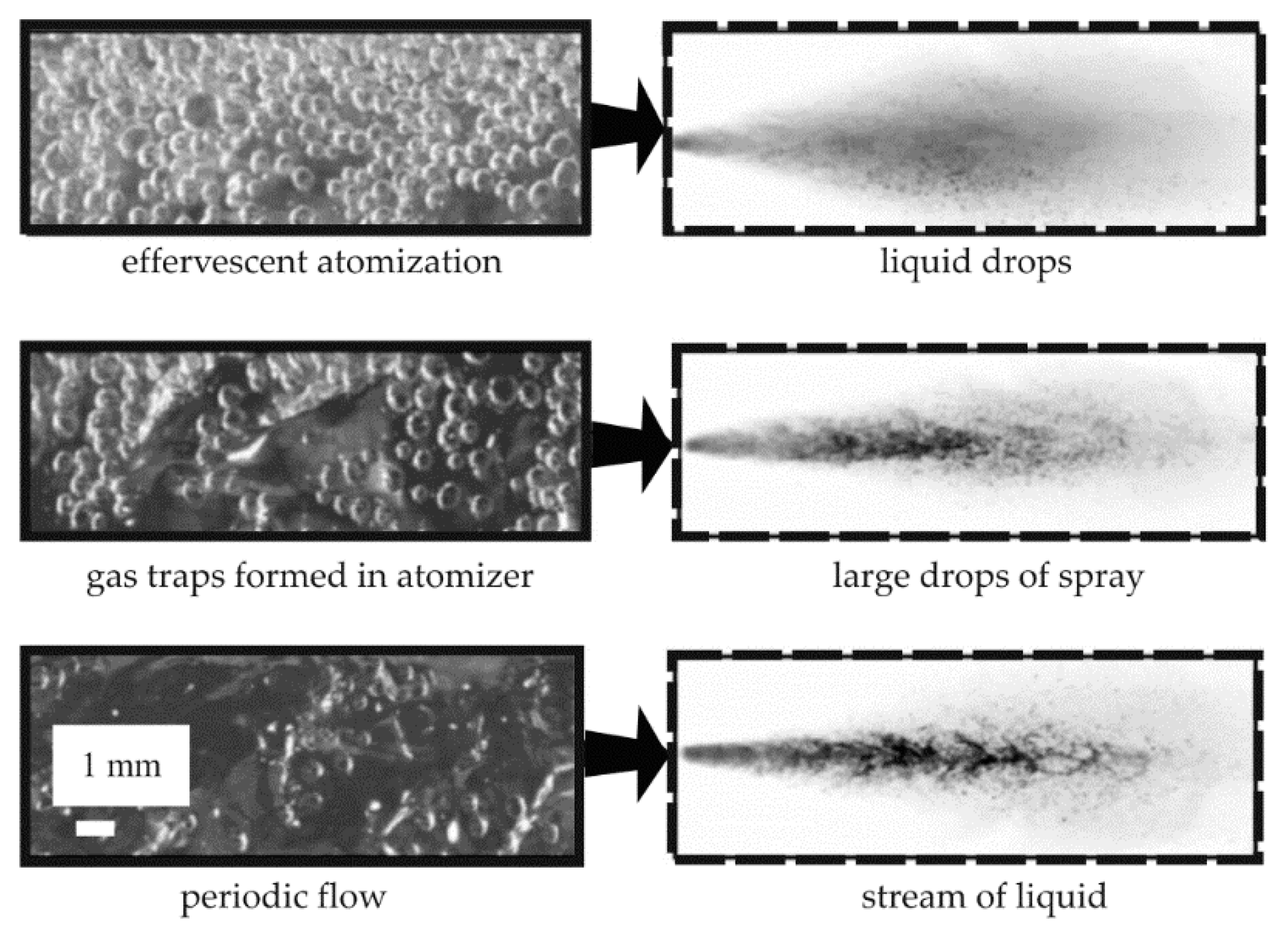

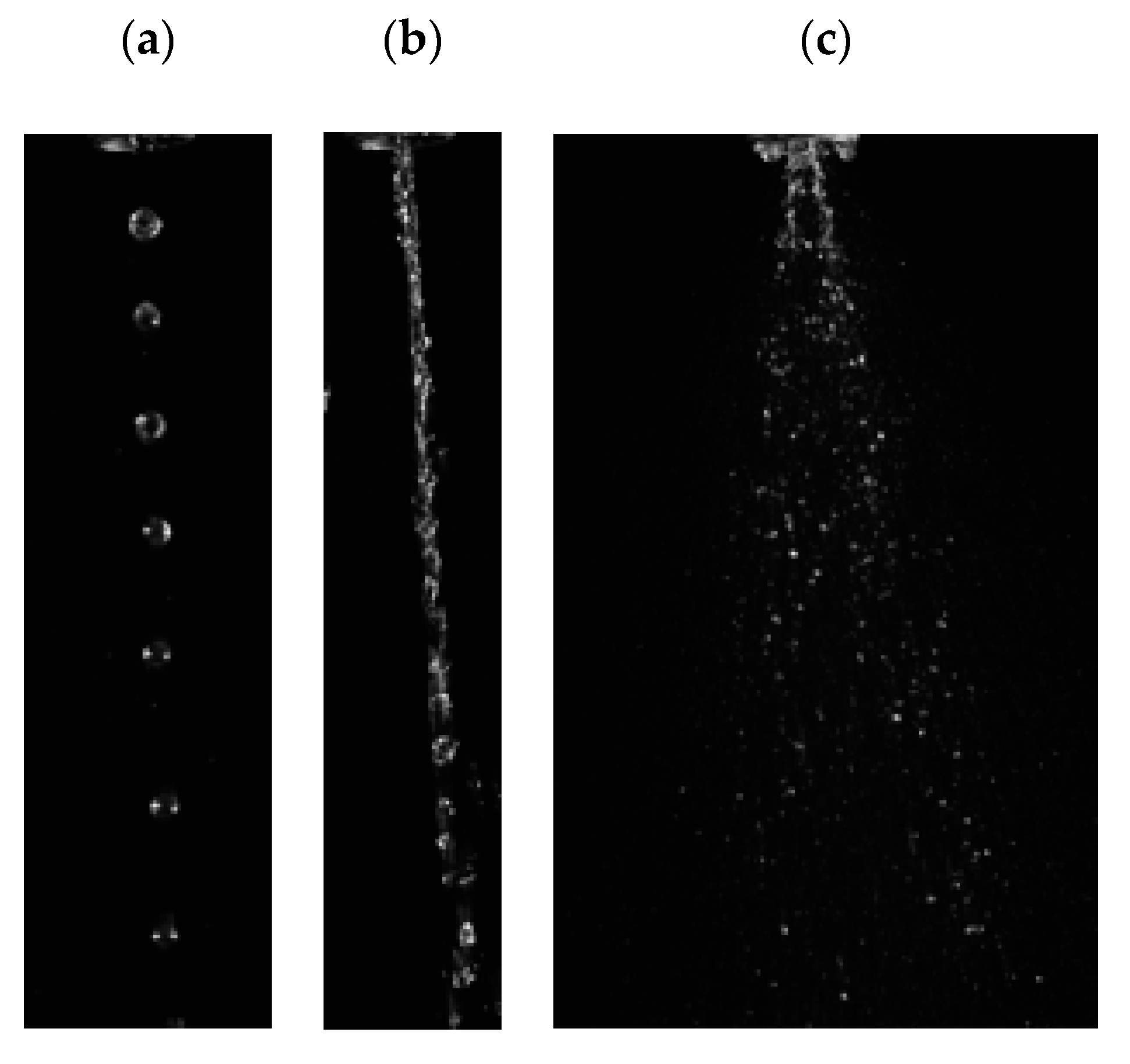
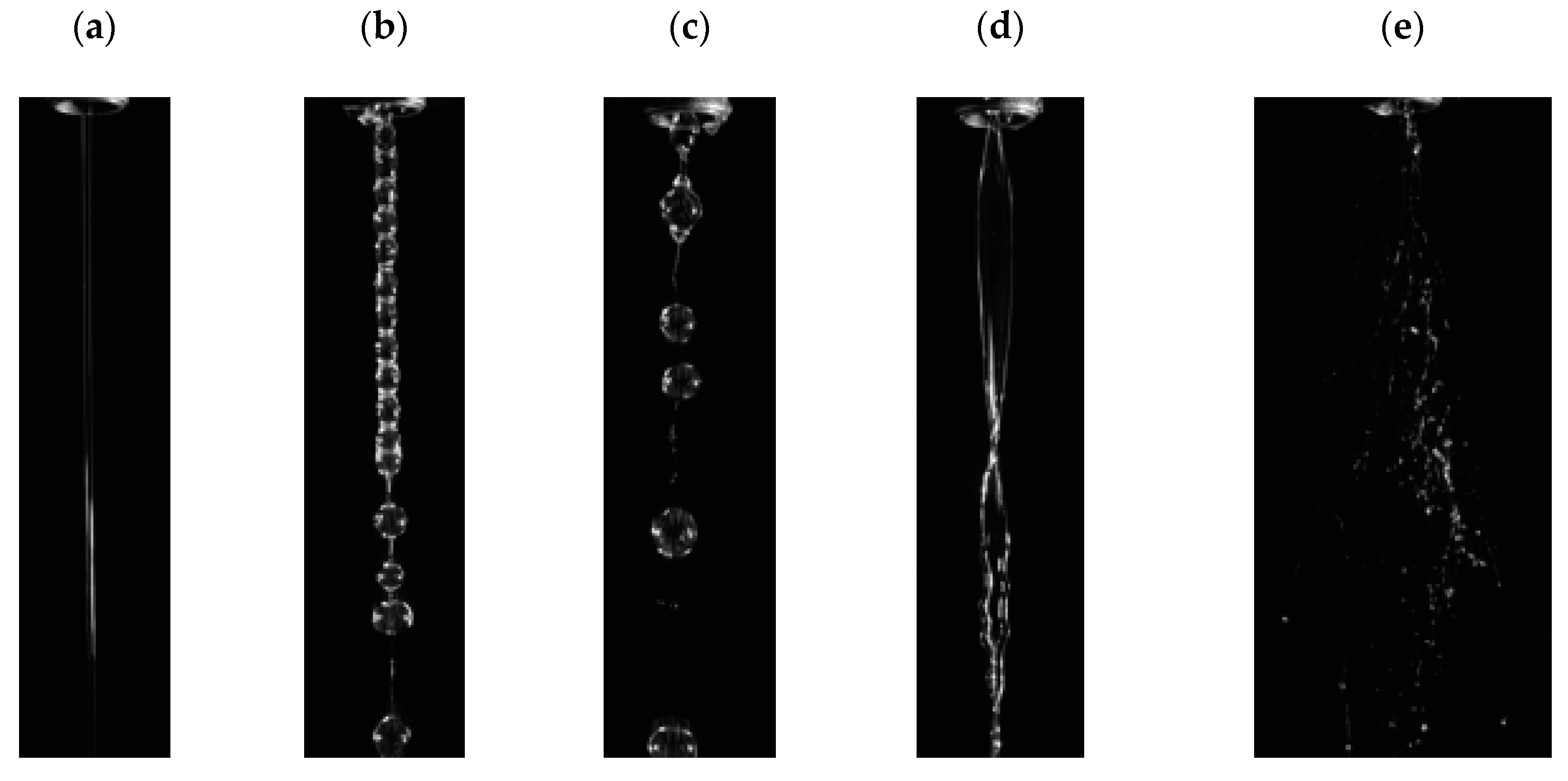
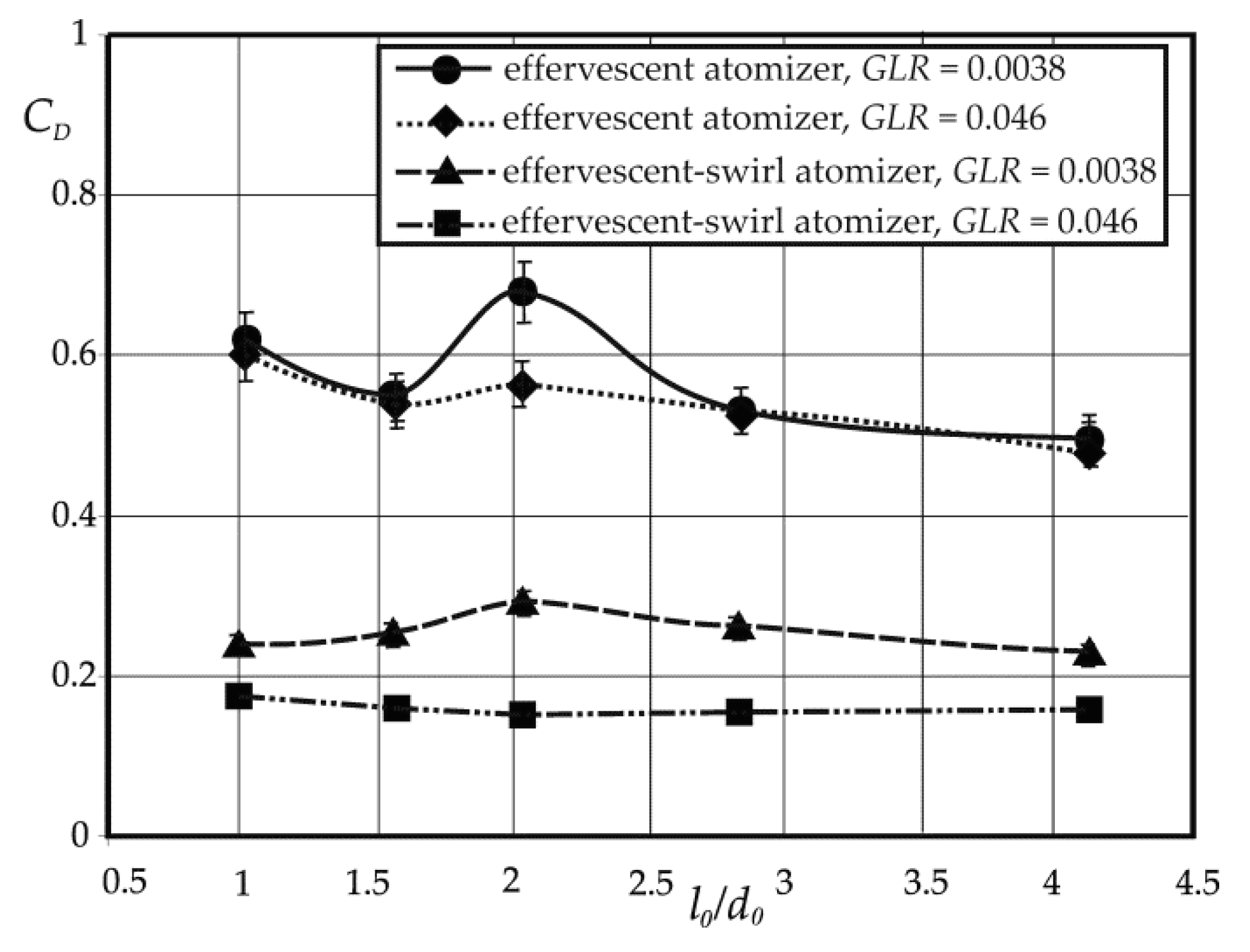
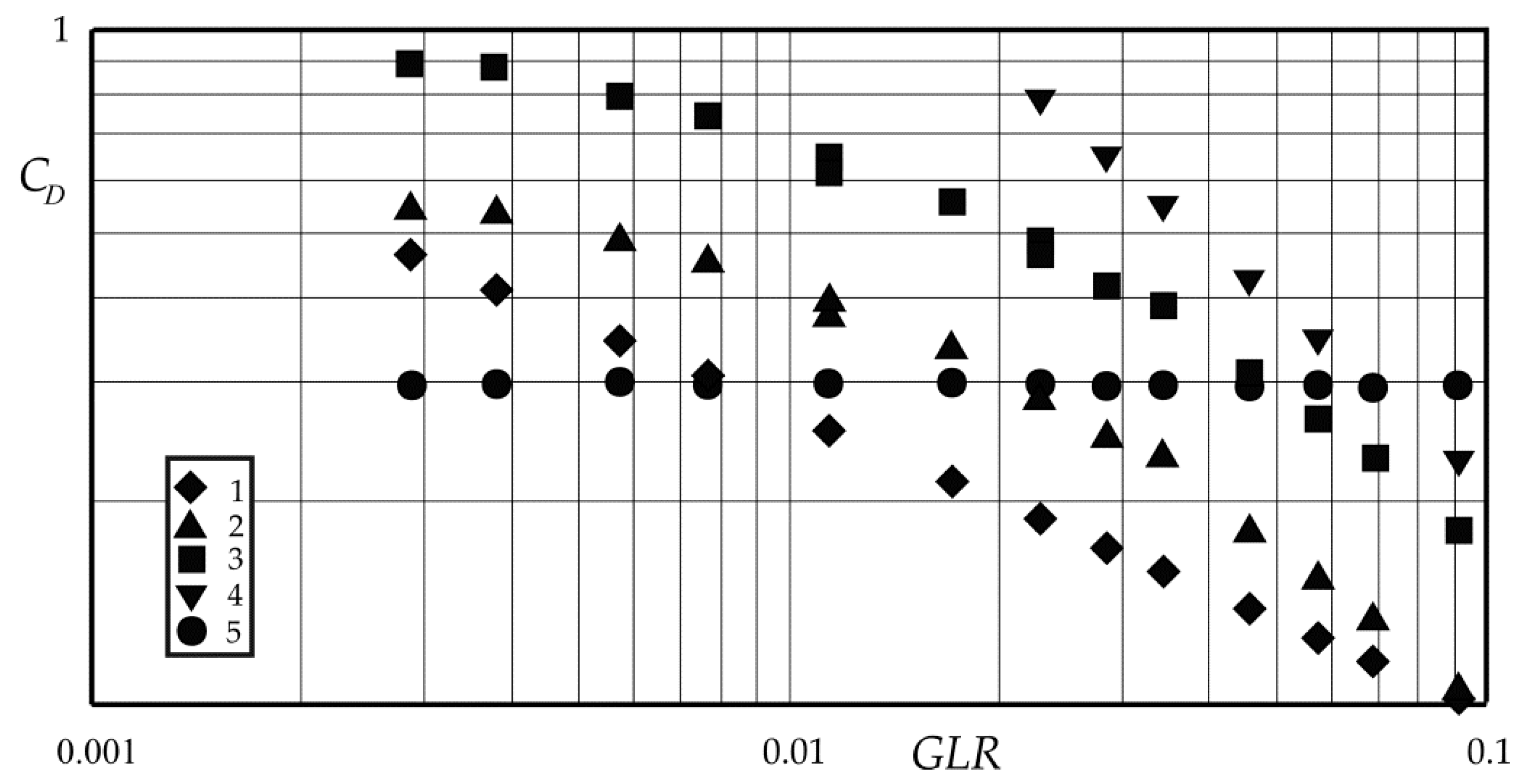
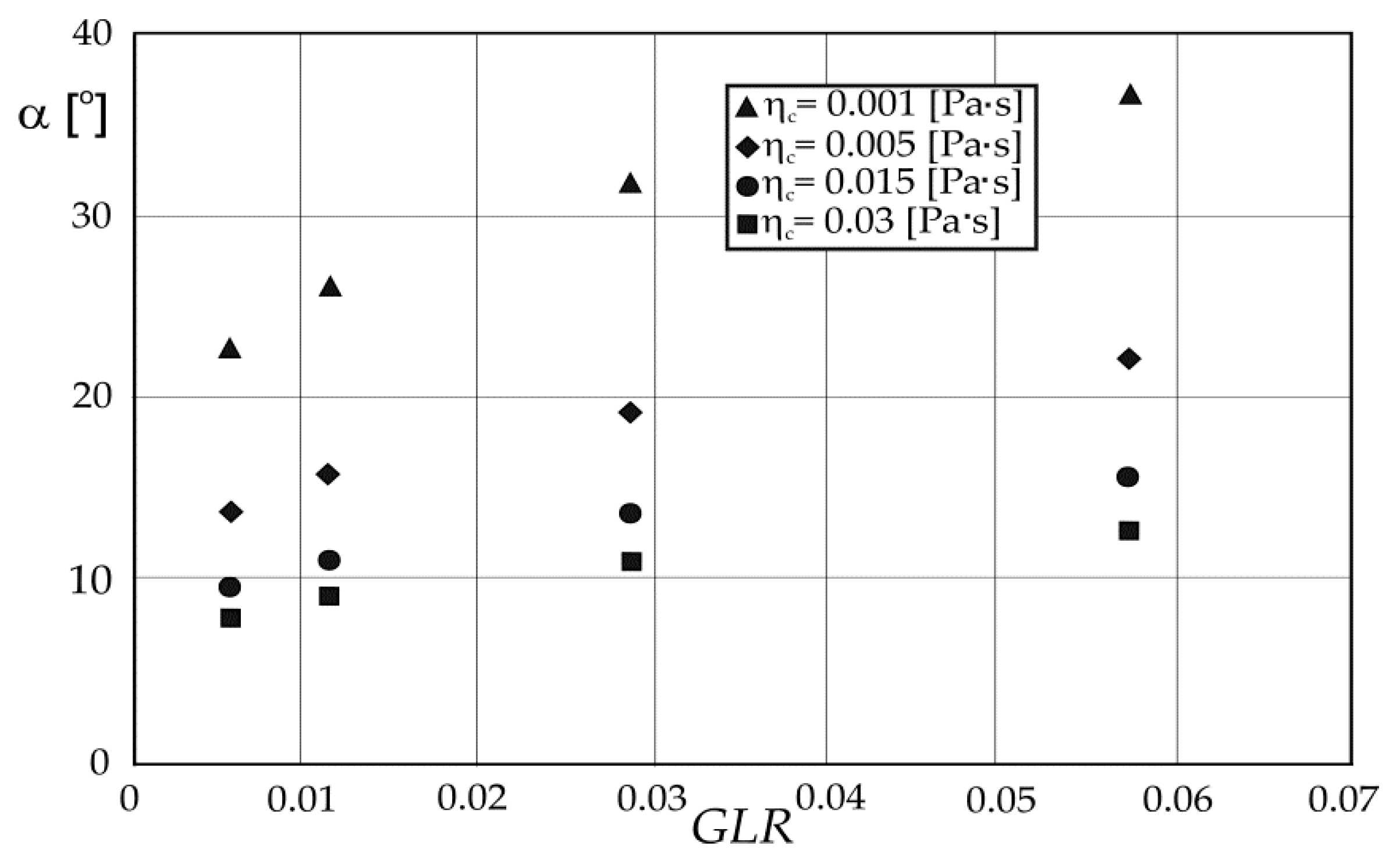
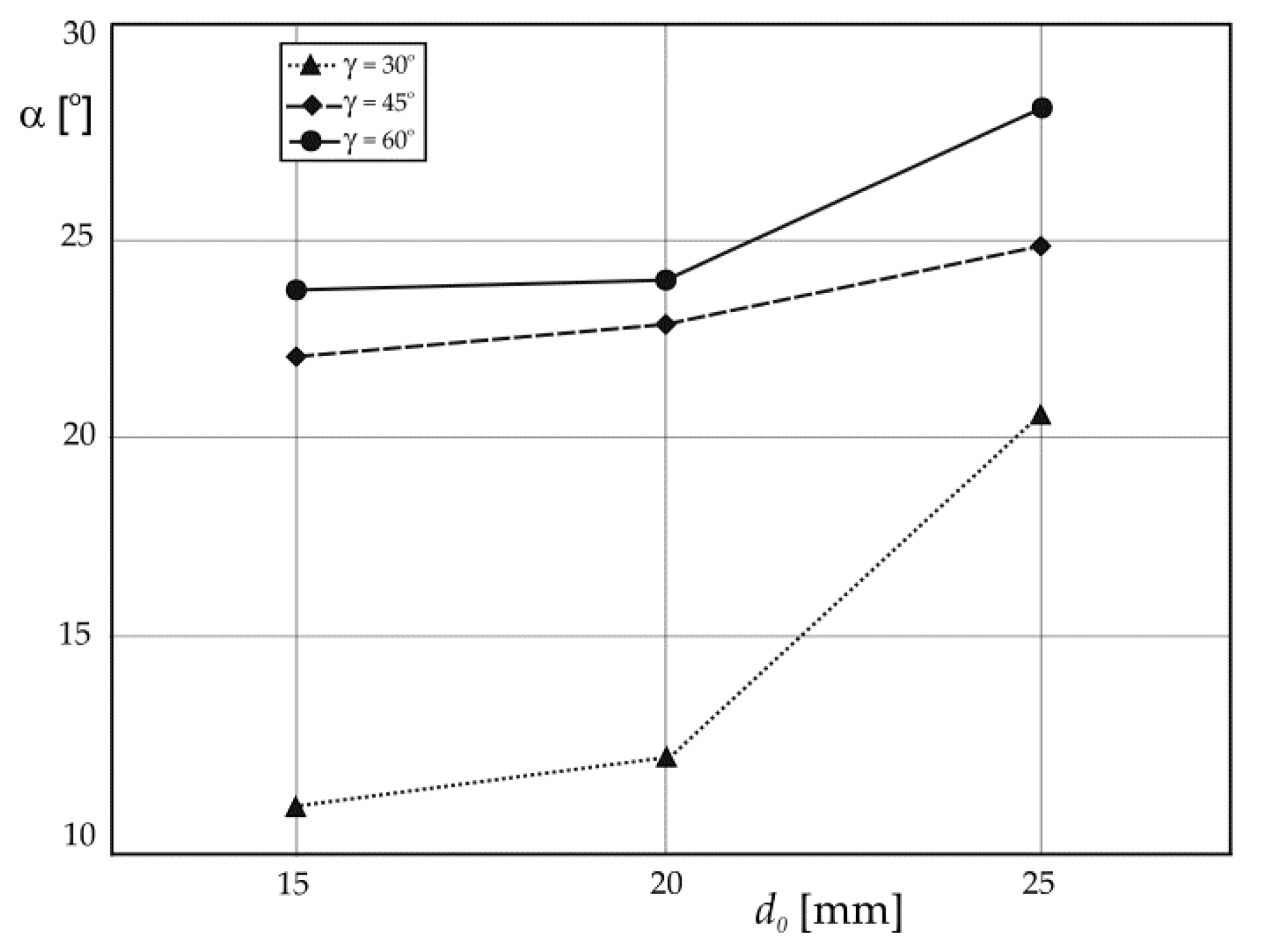
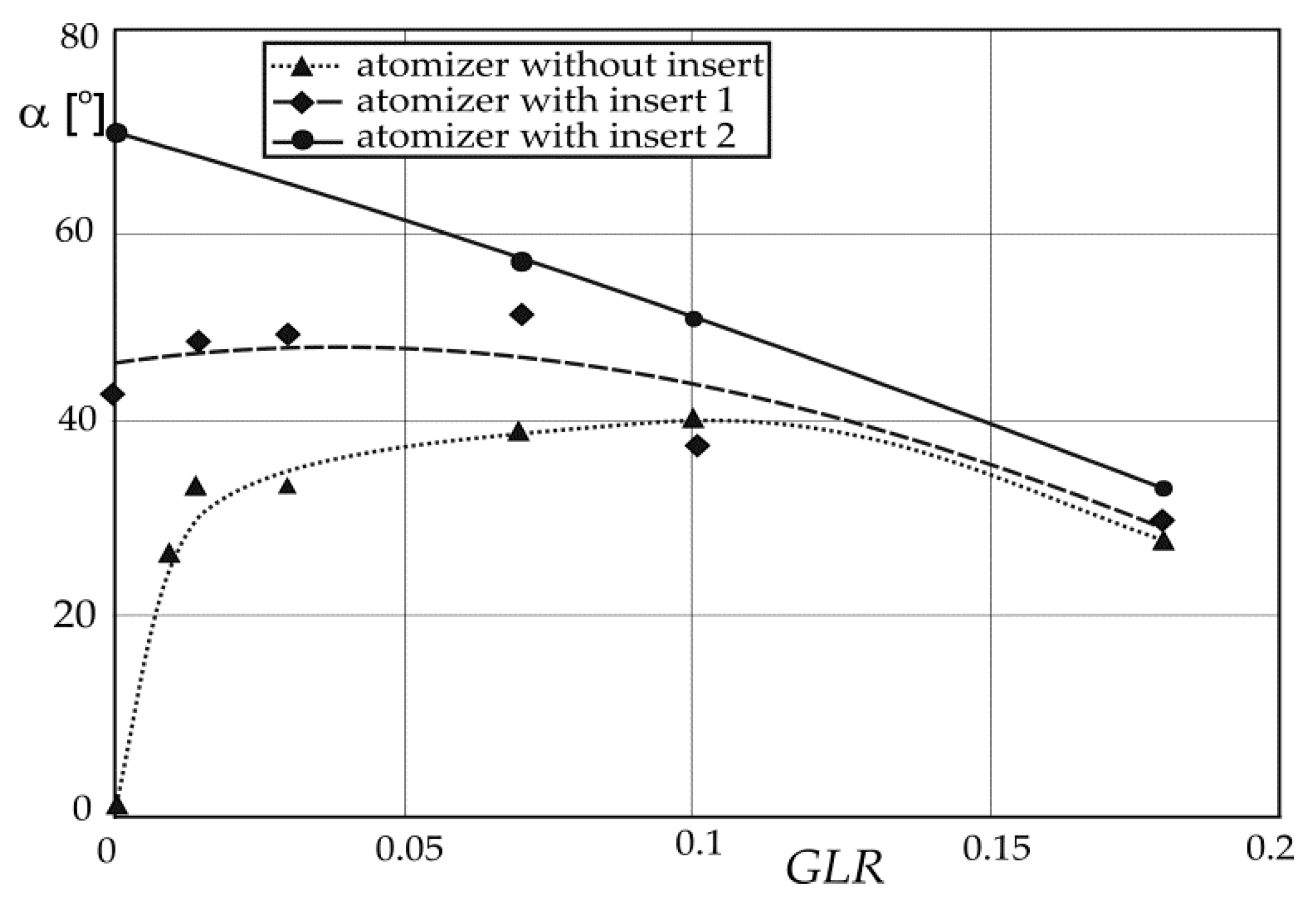

| ηc [Pa · s] | ρc [kg/m3] | c |
|---|---|---|
| RSP1 | 0.020 | 0.015 |
| RSP2 | 0.020 | 0.020 |
| RSP3 | 0.020 | 0.025 |
| RSP4 | 0.020 | 0.020 |
| RSK1 | 0.020 | 0.015 |
| ¦Çc [Pa · s] | ρc [kg/m3] | c |
|---|---|---|
| RSP1 | 0.020 | 0.015 |
| RSP2 | 0.020 | 0.020 |
| RSP3 | 0.020 | 0.025 |
| RSP4 | 0.020 | 0.020 |
| RSK1 | 0.020 | 0.015 |
Publisher’s Note: MDPI stays neutral with regard to jurisdictional claims in published maps and institutional affiliations. |
© 2021 by the authors. Licensee MDPI, Basel, Switzerland. This article is an open access article distributed under the terms and conditions of the Creative Commons Attribution (CC BY) license (https://creativecommons.org/licenses/by/4.0/).
Share and Cite
Czernek, K.; Hyrycz, M.; Krupińska, A.; Matuszak, M.; Ochowiak, M.; Witczak, S.; Włodarczak, S. State-of-the-Art Review of Effervescent-Swirl Atomizers. Energies 2021, 14, 2876. https://doi.org/10.3390/en14102876
Czernek K, Hyrycz M, Krupińska A, Matuszak M, Ochowiak M, Witczak S, Włodarczak S. State-of-the-Art Review of Effervescent-Swirl Atomizers. Energies. 2021; 14(10):2876. https://doi.org/10.3390/en14102876
Chicago/Turabian StyleCzernek, Krystian, Michał Hyrycz, Andżelika Krupińska, Magdalena Matuszak, Marek Ochowiak, Stanisław Witczak, and Sylwia Włodarczak. 2021. "State-of-the-Art Review of Effervescent-Swirl Atomizers" Energies 14, no. 10: 2876. https://doi.org/10.3390/en14102876
APA StyleCzernek, K., Hyrycz, M., Krupińska, A., Matuszak, M., Ochowiak, M., Witczak, S., & Włodarczak, S. (2021). State-of-the-Art Review of Effervescent-Swirl Atomizers. Energies, 14(10), 2876. https://doi.org/10.3390/en14102876









